Marie Antoinette
 for sexual content, partial nudity and innuendo.
for sexual content, partial nudity and innuendo.
Reviewed by: Michael Karounos
CONTRIBUTOR
| Moral Rating: | Offensive |
| Moviemaking Quality: |
|
| Primary Audience: | Adults Teens |
| Genre: | Biography Drama Adaptation |
| Length: | 2 hr. 3 min. |
| Year of Release: | 2006 |
| USA Release: |
October 20, 2006 (800 theaters) |
| Featuring |
|---|
| Kirsten Dunst, Jason Schwartzman, Asia Argento, Rip Torn, Molly Shannon |
| Director |
|
Sofia Coppola |
| Producer |
| Fred Roos, Francis Ford Coppola, Paul Rassam |
| Distributor |
Milena Canonero won an Academy Award for the costume design of this film.
“Let Them Eat Cake”
“Marie Antoinette” would have been better titled “Dazed and Confused” or “Clueless in Paris.” In the opening scene, Marie Antoinette (Kirsten Dunst) arrives at the border of France only to be ceremonially stripped of her dog, of her clothing, and of her Austrian identity. The loss of identity is the governing metaphor of the first half of the movie. She can no longer be what she was, and she’s not allowed to be what the French want her to be: a queen.
The movie tracks her frustrated efforts to make love to her disinterested husband, Louis XVI (Jason Schwartzman), but her “rebellion,” such as it is, consists of eating lots of chocolates, drinking lots of champagne, and buying lots (and lots) of shoes. Had the movie been titled “Ismelda Marcos” it would have made no difference to the viewer.
It is difficult to understand what Sofia Coppola was thinking when she wrote and story-boarded this movie. Not only is Kirsten Dunst vacuous, but her voice is nasally, flat-pitched, and grating. How can a professional actress not understand how to inflect her lines? Unfortunately, the dialogue and the scenes are vacuous as well. One keeps waiting for something of substance to happen, but probably a third of the movie consists of Marie hanging out with her girlfriends, running upstairs, running downstairs, giggling, and eating still more chocolates.
There are also at least four different scenes in which we are forced to watch the girls (one can hardly call them women) ooh and ah over yards of fabric, shoes, hats, and hairdos. Additionally, we are treated to the decadent spectacle of dogs eating off plates on at least three different occasions, perhaps to remind us that while Marie and company ate cake, the peasants were starving. Unfortunately, we never see anything but silk, brocade, and make-up. Starving peasants are an abstraction that the movie can’t be bothered to visualize.
At one point, her advisor tells her that she has already spent her allotment of 50,000 francs for the month, but Marie nonetheless chooses to dip into her charity budget for garden trees. This could potentially have been a serious moment, but it is treated like every other incident, with no distinguishing tone to give the viewer insight into either the character or the film’s perspective.
Marie is later encouraged by her brother to curb her entertainments and to change her companions. Although she ignores this advice as well, it is seen by the viewer more as the error of a foolish person, rather than as the rebellious action of an intelligent one.
Indeed, “Marie Antoinette” is such a bad movie that one is tempted to think of director Sofia Coppola herself as a type of queen flattered by admirers who are too frivolous or dishonest to tell her that her lavish entertainment is criminal.
In the end, the movie spends a few minutes on the peasants arriving at Versailles to air their grievances, but Coppola purposely keeps them faceless, showing their sharp weapons in stark relief, but never showing a sympathetic shot of an individual. Rather, during these moments of turmoil, we see only the concerned expressions of the king and queen as they bravely await the judgment of fate.
It is a revisionist movie whose judgment of the royal couple is sympathetically expressed several times. When Louis becomes king, he falls to his knees and prays because he says, “We are too young to rule.” When her brother confronts both her and Louis about the lack of movement on producing an heir, he concludes that “The king and queen are blunderers.” Louis plays with horses and likes locks. Marie eats sweets and laughs a lot. They are teenagers in a turbulent world. It’s not their fault. Nothing is their fault.
Ultimately, the movie’s greater sin is that it refuses to take itself or its subject seriously. The French Revolution is the defining event of the modern era, and its repercussions are still being felt in Europe. The creation of a European constitution without mention of God in its 200 pages is a direct consequence of the French Revolution, and yet Coppola couldn’t be bothered to give us a three dimensional portrait of a real and tragic person who lost her life as a direct consequence of the policies that she and her husband oversaw.
Given the opportunity to portray a great, if flawed, woman, Sofia Coppola chose to make her an American teenager. Such a flagrant waste of money deserves a revolution of its own, and viewers are strongly encouraged to not spend a penny on such a travesty of history and character.
Violence: Mild / Profanity: Minor / Sex/Nudity: Moderate
See list of Relevant Issues—questions-and-answers.


Average / 5
Kirsten is much better suited to play a preppie, like in “Mona Lisa Smiles,” or as Spiderman’s girlfriend. Of course, much of the music in this movie is whacked out. Some of it fits and is enchanting, but the punk/funk stuff does not work. Wonder why they ended it the way they did, not revealing how it all turned out. (No spoilers here.) One would do better by reading a history book and saving their money.
Average / 3
As far as morality, the main issue here is sexuality. Nudity or partial nudity is present twice when Antoinette is dressed by other women. Once is in a darkened tent and she is briefly shown from behind in the dim light. In another scene her bottom is covered by the bed and she covers her chest with crossed arms. Much of the movie centers around her unconsummated marriage to Louie with everyone demanding her to produce an heir. She attempts to strike his interest but it is very innocent and clumsy between them and she repeatedly fails. Antoinette only puts her arm around Louie and snuggles close… that is all. The worst scene is when Antoinette has an affair, late in the movie, with a Swedish officer. Only her fan and her propped up legs conceal her nudity but the scene is not very drawn out. Most of the sexuality in the film is banter and gossip that is exchanged between various people but it is not nearly as bad as what is usually present in films, although it happens frequently. The king also flaunts his mistress and in one scene he chases her into the bedroom, she meowing and him barking. Nothing explicit really goes on and their silly behavior is meant to be humorous more than anything. Later in the film though, there is proof that he had rather keep his mistress and risk salvation for a life of sin. The priest will not hear his confession so Louie has the mistress sent away, much to the king’s despair.
There is also much drinking of champagne, smoking of pipes, and gambling. Antoinette actually gambles away money that was meant to go to charity. There is also a brief scene when a woman at a party appears to snort a substance from the back of her hand. It could’ve been snuff but I suspect it was cocaine. It’s very brief and could be easily overlooked by many.
If there is any lesson to be learned from this film, it is to not put our trust in riches. We see that they are not enough to provide happiness for Antoinette, who is missing so much more from her life. The ransacked palace of Versailles is shown in the end, with broken chandeliers, etc.
Average / 3
That’s about it. What an awful movie—I wish I could get back my night with my husband. This movie drags and drags and drags on. There are parts where I said out loud, 'Oh come on, this is so boring!'. I actually fast forwarded the movie towards the end because I just wanted it to be over!!!… Kept expecting it to get better—it didn’t! Did I mention it was awful? I needed to be said one more time. This movie was terrible. The costumes were the only GOOD thing about this movie. …Two thumbs WAY DOWN!
Very Offensive / 4
Better than Average / 4
Better than Average / 3

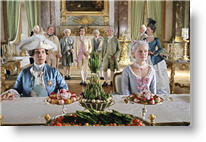
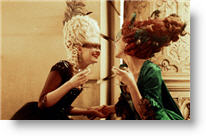
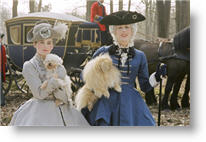
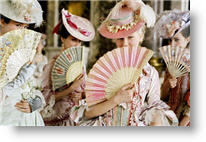


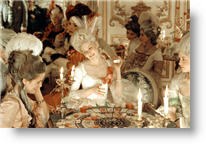
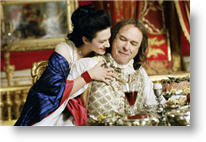
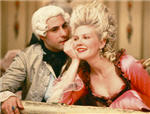

My Ratings: Better than Average / 4